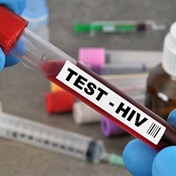French virologists said they had found a new subtype of the Aids virus that appears to have jumped the species barrier to humans from gorillas.
The new strain, found in a woman from Cameroon, West Africa, is part of the HIV-1 family of microbes that account for the vast majority of cases of human immunodeficiency virus (HIV), they said.
Until now, all have been linked to the chimpanzee.
The new subtype has been called P, adding to three established HIV-1 subtypes -- M, by far the most prevalent, and O and N, which are rare.
There is also an HIV-2 which is a minority viral family and is also suspected to have origins in non-human primates.
Woman from Cameroon first recorded case
The virus was sequenced from a blood sample taken from an
unnamed 62-year-old woman who moved to Paris from Cameroon,
according to a letter published by the journal Nature Medicine.
In 2004, shortly after moving to the French capital, the woman was tested for HIV. She responded to diagnostic tests for HIV-1 but further tests failed to pinpoint the viral subtype.
The virus was genetically decoded and then put through a computer model to compare its evolutionary past against known viruses, both HIV and its equivalent in apes, called simian immunodeficiency virus (SIV).
The strain was a "significant" match with SIVgor -- an immune deficiency virus found in gorillas.
"The most likely explanation for its emergence is gorilla-to-human transmission of SIVgor," the letter says.
New finding contradicts pervious beliefs
The research was headed by Jean-Christophe Plantier at a
national referencing laboratory for HIV at the Rouen Hospital
Centre, north-western France.
HIV is believed to have jumped from humans from their closest animal relatives more than a century ago, in west-central Africa.
Analysis of tissues preserved by doctors in the colonial-era Belgian Congo shows that HIV-1 began spreading among humans at some point between 1884 and 1924, according to an investigation published last October.
But until now, the known vector has been the chimpanzee.
Some experts have suspected that the gorilla may have been implicated in the N subtype, but this is the first time that a link has been so clearly defined.
"A gorilla origin is highly likely" in the new P subtype, Marie Leoz, one of the research team, told AFP.
"For the time being, it's the closest source. What is still quite difficult, though, is to date when the first transmission of the virus took place, because there are still very few gorilla strains that are available."
Woman has no sign of Aids so far
Leoz also said subtype P was probably rare among humans, but
further work was needed to confirm this.
The Cameroonian woman has no sign of Aids, is receiving treatment and has a stable count of viruses and of CD4 cells, a key benchmark of immune-system fitness, said Leoz.
There are several theories that seek to explain how SIV entered humans. An infected animal bit a human, or a SIV-infected ape was butchered and sold for bush meat, and the virus entered the bloodstream through tiny cuts in the hand, according to these hypotheses.
Aids first came to public notice in 1981, when alert US doctors noted an unusual cluster of deaths among young homosexuals in California and New York.
It has since killed at least 25 million people, and 33 million others are living with the disease or HIV, the virus that destroys immune cells and exposes the body to opportunistic disease. – (Sapa, August 2009)
Read more:
World cup may boost HIV infection
Govt gives R45m to new Aids plan




 Publications
Publications
 Partners
Partners










